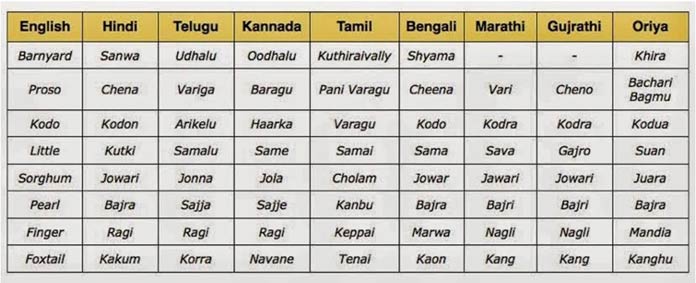Millets are tiny seeds of the grass family that originated in Africa and Asia. Consumed traditionally in South India, these easy to cook goodies are nutritious, cultivated with less water, are pest resistant and therefore environment friendly. They come at a marginally higher expense but are richer in protein, fat, fibre and other nutrients than grains like wheat and rice.
Common Names
- Sorghum – jowar
- Pearl millet – bajra
- Foxtail millet – navane
- Finger millet – ragi
- Proso millet – baragu
- Little millet – same
- Barnyard – oodalu

Why opt for millets over other grains?
Millets are a powerhouse of the following nutrients:
- Fibre offers satiety therefore is a good choice to manage blood sugars and diabetes
- Beta-glucan [soluble fibre] lowers cholesterol and triglycerides
- Resistant starch helps in the growth of good bacteria in the gut
- Bran is not digested and aids easy bowel movement preventing constipation
- The healthy fats in it strengthen nerves
- Millets contain higher amounts of protein in comparison to rice and wheat. Typically grains lack an essential amino acid called lysine. Finger and foxtail millet contains more lysine. High protein content increases serotonin which is a feel good factor and it helps to induce sleep
- B vitamins, B3, B6, and folic acid makes one feel energetic
- Magnesium is an anti-stress mineral and together with potassium helps to reduce blood pressure and boosts heart health
- Calcium and phosphorus are good for bone health, however the absorption of calcium may be not be optimal due to the presence of anti-nutrients like phytates, phenols, enzyme inhibitors and tanins
- Iron is vital for stamina and its absorption in finger millet [ragi] can be enhanced by malting.
How to consume millets ?
Most of the common food items prepared with rice or wheat can be replaced with millets either partly or whole.
To list a few:
- Dosa
- Idli
- Porridge
- Rotis
- In place of semolina for upma
- Puffed / popped millet
- Flakes
- Flour
- Malted
- Baked goods including bread
- Any rice dishes
- Popped millets are popular snacks
Nutrition alert
Millets contain some phytonutrients such as trypsin inhibitors, phytic acid, tanins, oxalates and goitrogens which are anti-nutritional properties that reduce the absorption of other vital nutrients such as calcium, iron, magnesium and iodine.
Processing millets reduces these inhibiting factors and increases absorption of calcium and iron. But there are also some losses of bran, B vitamins and essential fatty acids. Germination or sprouting, fermenting, soaking, parboiling, roasting, and cooking can be commonly practiced at home.
Storage Tip
- Purchase in small quantities
- Refrigerate or freeze
- Store in an air tight container to prevent spoilage of fats or rancidity.
Not just a bird feed but big on benefits, millets are slow digesting and ideal for people with diabetes, heart issues and weight watchers. Millets are gluten free grains and a convenient alternative for gluten sensitive.
Recipe: Palak millet khichdi
Food fact
Cooking palak enhances the absorption of nutrients. Combining millets and dals improve protein quality
Ingredients
- Oil ½ tsp
- Jeera ½ tsp
- Green chilly 1 whole
- Pepper corn a few
- Ginger ½ inch
- Palak puree 1 bunch [blanched and pureed]
- Millet of choice 1 katori
- Moong dal and tur dal mixed 1 katori
- Ghee ½ tsp
Preparation method
- Warm ½ tsp oil in a pressure cooker
- Crackle jeera and pepper
- Saute green chilly and pounded ginger
- Add millets and dal with 6 cups of water
- Pressure cook for 3 whistles
- Allow to cool
- Add palak puree and cook on slow fire for 5 minutes
- Drizzle ½ tsp ghee
- Serve hot.
 Spot an error in this article? A typo maybe? Or an incorrect source? Let us know!
Spot an error in this article? A typo maybe? Or an incorrect source? Let us know!
